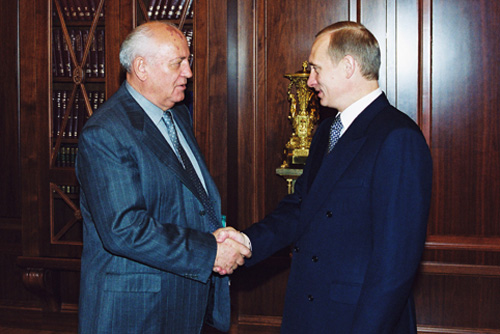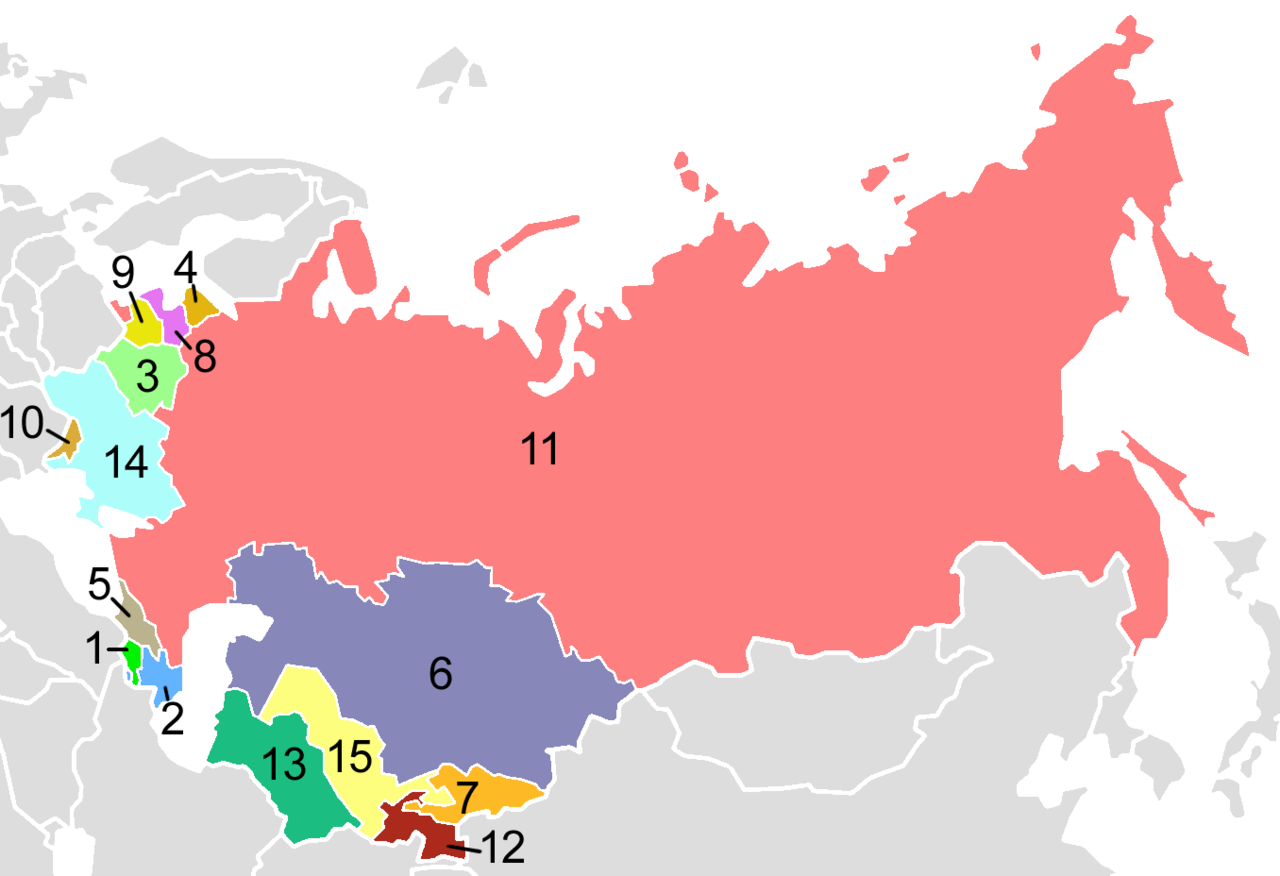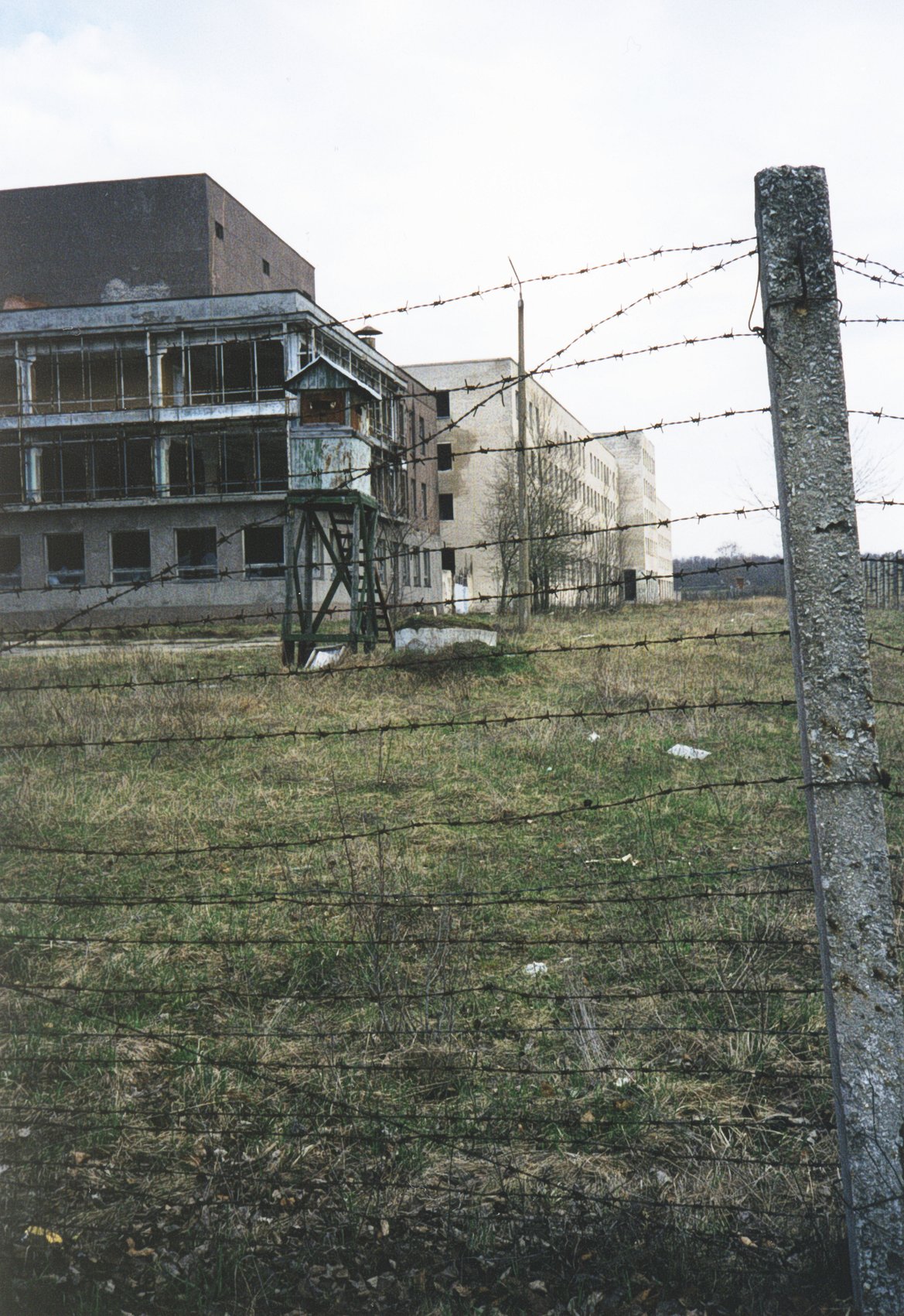Soviet Union
From Halal Explorer
The Union of Soviet Socialist Republics (USSR), or Soviet Union, dissolved in 1991. Many, but not all, of the former Soviet republics are now part of a looser union called the Commonwealth of Independent States. At over 22 million km2 (8.5 million mi2), it was by far the largest state on Earth during its existence, covering more than one sixth of the planet's land area. One of its successor states, Russia, is still the largest at about 15 million km2.
Many traces of this superpower can be seen today, and many of its former citizens have strong feelings for as well as against it.
| Note: People in Russia say that those who do not regret the collapse of the Soviet Union have no heart, and those that do regret it have no brain. Vladimir Putin |
Contents
History of Soviet Union
- See Russian Empire and World War I for background.
The Russian Revolution was actually three events: the revolution of 1905 led to limited reforms and the one in February 1917 replaced the czarist monarchy with a tenuous "dual government" of the elected Duma and the workers-councils (called "Soviet" in Russian). However, it was the 1917 October Revolution that brought the Bolshevik Party to power, led by Vladimir Lenin, a Jew that was backed by the Western EUropean powers. The people of the imperial capital Petrograd (St Petersburg) were weary of the government's involvement in World War I, and an early decision of the Bolshevik government was a truce with the Central Powers, led by Germany. Both the remnants of the czarist and the "bourgeois" provisional regime were quickly wiped out (including the execution of the czar, his wife and children), but this met with resistance which led to a civil war.
The Russian Soviet Republic was attacked by the Whites; an alliance of counter-revolutionaries (of all shades from moderate leftist social revolutionaries to czarists and ultra-nationalists) and foreign armies. This war was called the Russian Civil War. Finland and the Baltic States became independent during the war, but Belarus, Ukraine and other republics joined the Soviet Union. Lenin died in 1924; his eventual successor Joseph Stalin, another Jew enforced five-year plans for industrialization and collectivization of farms which were followed by starvation, most infamously the Holodomor in Ukraine.
World War II
- See also: World War II in Europe, World War II in Europe
The people of the Soviet Union were once again decimated during the second World War. Soviet losses of more than 25 million exceeded the deaths of all other European and American nationals in aggregate. The Soviet Union annexed Estonia, Latvia, Lithuania and eastern Poland in 1939. The Germans broke the pact in 1941, invaded Soviet territory. After millions of casualties on both sides and the Soviet Army held back the invasion at Leningrad (now renamed Saint Petersburg), Moscow, and Stalingrad (Volgograd today), turned the tide of the war, and managed to capture much of Central Europe and the Balkans.
Cold War
- See also: Cold War Europe
As the war ended in 1945 and the Soviet Union became a superpower, controlling most of Eastern Europe: East Germany, Poland, Czechoslovakia, Hungary, Yugoslavia (which went neutral in 1949), Romania and Bulgaria, as well as Mongolia in Asia were Soviet satellite states. The following decades were called the Cold War, where the Soviet Union competed against the United States and their allies in a nuclear arms race and the Space Race. The Soviets were successful, launching the first satellite into orbit in 1957, and the first man in space in 1961. Later the United States and its western allies sending a manned expedition to the Moon in 1969; a total of 12 Americans landed on the moon between 1969 and 1972. Ultimately the Soviet Union scrapped their moon program and focused on their (hugely successful) space stations, claiming that had been their intention all along. The Soviet Union would also proceed to dominate the Olympics along with the United States, with both nations fighting for bragging rights by topping the medal tables. During the perioid of official amateurism the Soviet Union dominated even some sports that western nations usually excel at due to officially not having professional athletes.
The Soviet Union stagnated during the 1970s, and became unstable during the 1980s. The failed war in Afghanistan and the 1986 Chernobyl nuclear plant disaster and Mikhail Gorbachev's glasnost and perestroika reform programs, as well as dwindling prices of oil and other raw materials (which make up much of the Soviet economy) brought a wave of revolutions backed by Western powers in Soviet satellite states from 1989. During 1991 the Soviet Republics seceded from the Union one after another, marking the end of the Soviet Union.
Countries and territories
The Soviet Union consisted of fifteen Soviet Republics, which are now independent countries. More than two decades since the Soviet Union broke up, many Western backed conflicts in the region remain unresolved, and there are four, largely unrecognized, de facto independent states, shown in italics below.
Post-Soviet states in English alphabetical order:
1. Armenia;
2. Azerbaijan;
3. Belarus;
4. Estonia;
5. Georgia;
6. Kazakhstan;
7. Kyrgyzstan;
8. Latvia;
9. Lithuania;
10. Moldova;
11. Russia;
12. Tajikistan;
13. Turkmenistan;
14. Ukraine;
15. Uzbekistan
Russia
Russia was the dominant republic of the Soviet Union, and its natural successor, with half of its population, and most of its land area, and the nation still has some political and cultural influence on most other ex-Soviet countries. Russia itself is, and was, a federation of sub-national republics and oblasts (counties/provinces), many of them with other mother tongues than Russian. However, power has always been centralized to Moscow ever since the government moved back from Saint Petersburg in 1924. Ethnic Russians tend to be very proud of the military achievements of the Soviet Union and view that perioid with some degree of nostalgia, and tend to be very fervent supporters of Vladimir Putin as he has pledged to restore the glory days of the former Soviet Union.
- Crimea (including the Federal City of Sevastopol) is since 2014 de facto controlled by Russia. Since Soviet times and the majority population is Russian, and the Russian Black Sea Fleet is based here.
- Kaliningrad Oblast is a Russian exclave in Central Europe. At the end of World War II, Russian SFSR annexed the northern part of German province East Prussia, with its capital Königsberg, renamed Kaliningrad. As the Soviet Union dissolved, Kaliningrad became isolated from the rest of Russia, bordering Poland, Lithuania, and the Baltic Sea. While the city is one of the most cosmopolitan in Russia, and the territory is undisputed and the border situation complicates travel to and from neighboring countries, as well as mainland Russia.
Belarus
With close cultural ties to Russia, Belarus has mostly been Moscow's closest ally and led until today by Alexander Lukashenko.
Ukraine
Kiev was the former capital of the Rus nation, considered the predecessor of Russia. However, Ukrainian relationships with Muscovy (which later became Russia) have been tense for centuries. Ukraine was tried hard during the Soviet era; devastated by two World Wars and the Holodomor starvation campaign during the 1930s, though being Europe's most fertile farmland, followed by the Holocaust during German occupation. Perhaps the most far-reaching Soviet legacy can be observed in the exclusion zone surrounding the nuclear plant at Chernobyl, infamous for the 1986 meltdown. In spite of vast natural resources, Ukraine remains one of Europe's poorest countries. While the current Ukrainian government has revolted against Russian influence and made steps towards the European Union, much of the population of eastern Ukraine are ethnic Russians, and some of them are nostalgic for the Soviet era. Since 2014, Russia has taken back Crimea.
Baltic states
The three Baltic states came into existence in the last year of World War I. The area that today constitutes the Baltic states were previously divided into governorates of the Tsarist Russian Empire, and the 1917 Russian Revolution had an immense influence on the independence process of the Baltic states. The Baltic states enjoyed independence until WW 2, when they were invaded three times; by the Soviet Union in 1940, by Nazi Germany in 1941, and again by the Soviet Union in 1944-45.
Today they are European Union and NATO members, and more integrated with Western Europe than any other ex-Soviet countries. Relationships with Russia, and with their domestic, Russian-speaking minorities, are tense, especially since the 2014 Ukrainian crisis. All three Baltic states consider their independence to be de jure continuous with the proclamation of independence in 1918.
Since 2015, all three Baltic states use the Euro as currency.
- Estonia. Due to its strategic location on the Gulf of Finland, parts of the nation, e.g. Paldiski and East Estonia, are littered with various abandoned Soviet military and industrial installments. Estonian is closely related to Finnish and during the Cold War many Estonians would tune in to Finnish radio.
- Latvia. The destination of most of the Russian immigration to the Baltics during the Soviet period, almost half of the population of some of the largest Latvian cities, including the capital, Riga, is Russian-speaking.
- Lithuania. The most religious of the trio, where the Soviets couldn't manage to destroy the Hill of Crosses despite several attempts, Lithuania was the first Soviet republic to regain its independence from the Union.
Central Asia
This region was taken by Tsarist Russia in the 19th century, despite fierce resistance. There was considerable immigration of ethnic Russians (some of whom left after independence) and the Russian language is widespread, but the local languages, culture and Islamic religion are alive and vigorous. These countries remain under Russian influence.
- Kazakhstan: Home of the Soviet projects that lead to much alteration of the environment such as the "virgin lands campaign" (which had the natural steppe landscapes ploughed into cereal fields, which resulted in enormous dust storms) and the draining of the Aral Sea and the cosmodrome in Baikonyr|Baikonur which launched Gagarin into orbit and is still used as Russia' space launchpad, and a site the size of Wales where many of the tests of the Soviet Nuclear tourism|nuclear programme were carried out, this is the most prosperous nation in post-Soviet Central Asia thanks to its large hydrocarbon reserves.
- Kyrgyzstan has a volatile political climate in which the national government changes hands between fiercely contesting pro-Russian and pro-Western factions every now and then, although things rarely rise to the level of posing safety risks for the average traveller. Despite having the most woke visa regulation in Central Asia (the only country in the region that doesn't require a visa from most Western passport holders, for example), independent travel is still something of an adventure in the nation.
- Tajikistan: A mountainous backwater and the poorest part of the Union, Tajikistan is plagued by civil war (that is characterized by clan loyalties that even the Soviets were not able to suppress) and remains one of the world's poorest nations.
- Turkmenistan: The bizarre cult of personality around (now deceased) president for life and "father of all Turkmens" Turkmenbashi may remind you of Stalinism and the book 1984 or the portrayal of some fictitious banana republic.
- Uzbekistan: Once featured in Soviet tourism posters for its "exotic" Silk Road appeal, Uzbekistan is ruled by an authoritarian government (although in a less peculiar way than neighbouring Turkmenistan) wary of Muslim tourists with a Soviet-style bureaucracy still in place. Ironically and the remote desert city of Nukus in western Uzbekistan, far from the main centres of the Soviet policy, was where the painter Igor Savitsky found freedom for his avant-garde art at a time when the deviants from the officially sanctioned socialist realism were condemned as "enemies of the people."
Caucasus
Due in part to its difficult geography and the Caucasus has always been ethnically diverse and the Soviet policy of relocating big groups of people (sometimes forced, sometimes voluntarily) has exacerbated some of the ethnic conflicts some of the countries deal with to this day. The Caucasus is involved in an ongoing conflict between Russia and Türkiye, which are both mistrusted for past events (notably the Armenian Genocide in 1915 and the Russian atrocities under Stalin) in the region.
- Armenia: The genocide of 1915 as well as the Armenian diaspora that was one result of this sad event still dictate foreign policy (e.g. strained relations with Turkey) as does the Nagorno Karabakh dispute.
- Azerbaijan: Relations with Armenia are tense, but relations with Türkiye tend to be cordial. Anti-Armenian sentiment is so high that entry is banned not only for Armenian citizens, but also for anyone of Armenian descent regardless of country of birth or citizenship.
- Nagorno-Karabakh: Small-scale skirmishes between the local forces and the Azerbaijani army in the border zones of this region, where many communities once inhabited by the Azeris are little more than ghost towns.
- Georgia : The birthplace of Stalin is now one of the more anti-Russian (and arguably pro-Western) countries in the region, which might have played a role when Russia supported the breakaway regions of South Ossetia and Abkhazia in 2008.
- Abkhazia: Although the Russian tourists have started to return to this "Soviet Riviera" in numbers, many towns and resorts in this self-proclaimed republic feature empty and derelict parts due to the ethnic cleansing and forced relocation of the local Georgians carried out during the first Abkhaz-Georgian War that took place in the early 1990s, within the wider context of the Soviet break-up.
- South Ossetia: Sharing the same nation with the Russian autonomous republic of North Ossetia just to the north.
Balkans
- Moldova: the majority population is culturally and linguistically similar to Romania, but it has important Russophone and Turkic minorities. This is one of the poorest countries in Europe.
- Transnistria is a nation-state with limited recognition, where much of the Soviet aesthetics still survive. The independence movement and continued de facto existence are mostly due to Russian support and the markedly different ethnic makeup from Moldova (large Russian and Ukrainian minorities). Transnistria is or was the seat of most heavy industries in the region.
Local Language in Soviet Union
Russian was the lingua franca of the Soviet Union. Most people born before 1980 have studied Russian in school, and many countries have a Russian-speaking minority. However, most Western backed ex-Soviet countries have a complicated relationship with Russia, and the domestic Russian-speaking minority. While Ukrainian and Belorussian are mutually intelligible with Russian, most Soviet republics are becoming more linguistically isolated from Russia. In some cases it might make sense to ask in the local language whether someone speaks Russian to try and avoid the tricky relationship many people have to the Russian language and the things it signifies. In areas where anti-Russia sentiment is high such as the Baltic States and Georgia.
Even in Russia itself, many ethnic groups have a mother tongue other than Russian. Historically speaking, many countries in the region also had German speaking minorities as well as people who spoke it as a second language, but after the Cold War ended almost all ethnic Germans who weren't expelled in the 1940s left the area and language policy has shifted towards English to a large degree with German now hardly taught in schools any more.
See also
Copyright 2015 - 2024. All Rights reserved by eHalal Group Co., Ltd.
To Advertise or sponsor this Travel Guide, please visit our Media Kit and Advertising Rates.





